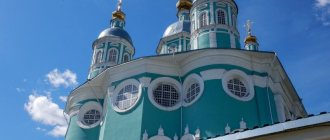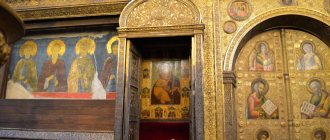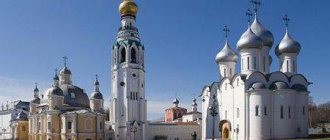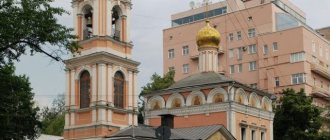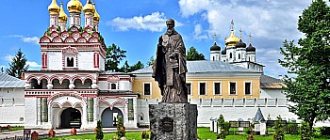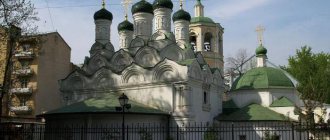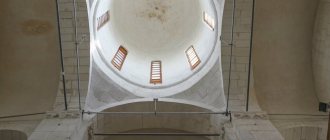In Yaroslavl, on the Spit of the Volga and Kotorosl rivers, stands the majestic Assumption Cathedral. His fate is tragic. Built at the beginning of the 13th century, it was burned and rebuilt several times until it was finally demolished in 1937. In 2004-2010, it was restored to coincide with the 1000th anniversary of Yaroslavl. For many centuries it was the spiritual and cultural center of the city.
History of the construction of the Assumption Cathedral
In 1215, the Rostov prince Konstantin Vsevolodovich (1186-1218, reigned in Rostov from 1208 to 1216) founded “a stone church in Yaroslavl in his yard in the name of the Mother of God of the Assumption.” At that time, this was the territory of the wooden Yaroslavl Kremlin, or, as it was also called, the Chopped City. In 1219, Rostov Bishop Kirill I (bishop from 1216 to 1229) solemnly consecrated it. This was the first stone building in Yaroslavl.
Soviet archaeologists, led by Nikolai Nikolayevich Voronin (1904-1976), one of the largest specialists in ancient Russian architecture, after the destruction of the cathedral in 1937, tried to find the remains of the foundation of the ancient pre-Mongol temple, but to no avail. However, based on individual archaeological finds, it was possible to recreate its appearance. It was built from thin red brick - plinth. The walls were decorated with white stone inserts with carved ornaments and masks. The floor was covered with multi-colored majolica tiles that resembled a carpet; it was one of the main decorations of the temple. The doors were upholstered in gilded copper.
In the first half of the 13th century, the “Savior” icon, the “prayer” icon of the Yaroslavl princes Vasily (1238-1249) and Constantine (1249-1257), was painted for the Assumption Cathedral. In 1238, Yaroslavl, like many other Russian cities, was burned by Batu. The Assumption Cathedral survived, but was completely plundered.
In 1501, there was a big fire in Yaroslavl, as a result of which the vaults of the temple collapsed. When sorting out the rubble, the relics of the noble princes Vasily and Konstantin Vsevolodovich were discovered. By 1516, a new temple, small in size, was erected. According to some sources, its appearance resembled the Annunciation Cathedral of the Moscow Kremlin. A small chapel was attached to it from the west “on the floors”. In 1612, in the Assumption Cathedral, Metropolitan Kirill II blessed Prince Dmitry Pozharsky to go with the militia to liberate Moscow.
The 17th century was the heyday of Yaroslavl, the formation of an original school of Yaroslavl architecture. The old Assumption Cathedral could no longer accommodate all the believers, and therefore in 1643 the construction of a new cathedral began, a little away from the old one. The old cathedral was ordered to be dismantled, leaving only the cellar where the “green and church treasury” was kept. The government chamber was built above it on the basis of partially dismantled walls.
In 1646 the new cathedral was consecrated. It was a small five-domed temple with a 55-meter hipped bell tower. On July 10, 1658, during another fire in Yaroslavl, it suffered: the domes, roof and some other external buildings burned down. Therefore, in 1659 it was rebuilt into a six-pillar, five-domed temple. Stone porches, characteristic of Yaroslavl buildings of that time, were added to the northern, western and southern entrances. A new tented bell tower was laid next to it.
In 1670 there was a new fire, after which the temple was rebuilt. In 1671-1674, its walls were covered with paintings, which survived until 1825. In 1788, in connection with the transfer of the center of the diocese to Yaroslavl, it became a cathedral. This required further restructuring and alterations.
In 1832-33, a small warm church was added to the southern wall in the name of the noble princes Constantine and Vasily. At the end of the 19th century it was combined with an expanded western porch. In 1836, according to the design of the architect Abraham Ivanovich Melnikov, rector of the Imperial Academy of Arts, a new multi-tiered bell tower, 70 meters high, was built instead of the old bell tower. An arch for passage was made at the bottom.
In old photographs you can see what the Assumption Cathedral in Yaroslavl looked like at the beginning of the 20th century.
Interior decoration of the Assumption CathedralKotorosl River
Recommend a place
10
3
Kotorosl is a river in the European part of Russia.
The length of the river is about 126 kilometers, and the area of its basin is 6370 square kilometers. The river flows through the Yaroslavl region through the city of Yaroslavl, as well as through the Rostov and Gavrilov-Yamsky regions.
In the 19th century, the Kotorosl River was navigable, and many boats with cargo were rafted along it. Today, in the middle reaches of the river there are many rest houses, summer cottages, and sanatoriums. The river is also popular among lovers of water tourism.
There is no exact information about the origin of the name. Until the 20th century, the name of the river sounded like “Kotorost” and probably came from the Old Russian verb “kotoratsya”, that is, to argue. The Kotorosl River begins at the confluence of two rivers - Vyoksa and Ustya, and this name, apparently, should reflect the “dispute” of these rivers about which of them is the beginning of the river.
Coordinates: 57.61553200,39.91244600
Assumption Cathedral in the Soviet years and today
The Assumption Cathedral was seriously damaged during the anti-Bolshevik Yaroslavl uprising (July 6-21, 1918). The walls were damaged by shelling, but were then repaired with funds from the church community.
Damage to the Assumption Cathedral during the Yaroslavl Uprising
Damage to the bell tower of the Assumption Cathedral after the Yaroslavl uprising
In 1922, the city labor exchange was located in the Assumption Cathedral; the most valuable items were transferred to the state. In 1924, a partial restoration was carried out. In 1929, the bell tower was dismantled, and a little later the church community was dissolved.
The premises housed a sewing workshop, a warehouse of art valuables, and then a granary. On August 26, 1937, the Assumption Cathedral was blown up, and a city park of culture and recreation was laid out in its place.
In 2004, according to the design of architect Alexei Denisov, construction of a new, larger one began on the site of the previous temple. Construction proceeded with scandals: they feared that the soil of Strelka would not withstand such a colossus and would “float”, that the temple would distort the historical appearance of the city... In addition, the new temple in its appearance is not similar to the previous one and stands out from the local style, inheriting more of the tradition of Moscow architecture. However, on September 12, 2010, the Assumption Cathedral was consecrated by Archbishop Kirill of Yaroslavl and Rostov.
The area of the temple is about 2 thousand square meters, the capacity is more than 4 thousand people, the height to the base of the cross is 50 meters. The ground floor will house the hall of church cathedrals, a museum, a refectory and the chambers of the ruling bishop. It is planned to erect a free-standing bell tower with a height of more than 70 meters. In the meantime, the bells are installed on a temporary belfry nearby.
Near the Assumption Cathedral from the Strelka side, on the site of the altar of the destroyed Assumption Cathedral in 1995, a statue of the Trinity . Artist - N. Mukhin, sculptor - I.B. Treyvus, architect - A. Bobovich. The uniqueness of this monument is that there are no similar sculptural images of the Trinity anywhere else in our country. It is not surprising that this composition caused rejection by part of the public.
Sculptural image of the Trinity near the Assumption Cathedral
Modern photographs allow you to see the current appearance of the Assumption Cathedral and its interior decoration. Of course, he became the decoration of Yaroslavl and without him Strelka would have looked unfinished.
View from the belfry of the Spaso-Preobrazhensky Monastery to the Assumption Cathedral
Domes of the Assumption Cathedral
Through the young foliage...
White walls and golden domes
Mosaic icon of the Dormition of the Blessed Virgin Mary above the entrance to the cathedral
Bells of the Assumption Cathedral
Interior decoration of the Assumption Cathedral
Iconostasis of the Assumption Cathedral
Golden domes of the Assumption Cathedral
The Assumption Cathedral is incredibly beautiful in the evening, in the rays of illumination.
Assumption Cathedral and the Eternal Flame in the evening
Assumption Cathedral in the evening
Domes of the Assumption Cathedral
In the backlight, the Assumption Cathedral looks especially impressive
Mosaic icon “Protection of the Blessed Virgin Mary” above the entrance to the cathedral
The Assumption Cathedral looks fabulous on a winter evening.
Winter evening
White and gold
Historical center of Yaroslavl
Recommend a place
4
The historical center of Yaroslavl occupies a huge area of more than 100 hectares. This section of the city contains about 140 cultural heritage monuments, which have been perfectly preserved to this day. First of all, these are buildings from the pre-Petrine period and classicism.
The authorities of Yaroslavl did their best to preserve the beauty of the city during the Soviet period, when monuments were demolished in all cities, and buildings were brutally destroyed or even given over to collective farms.
The Assumption Cathedral on Strelka, the Znamenskaya and Uglich towers, the Church of Simeon the Stylite, the Spaso-Preobrazhensky Monastery and much more have survived to this day. Of course, over many centuries of existence, all the monuments were restored. What man does not destroy, time will mercilessly destroy. But in general, the historical center conveys the atmosphere that reigned in Yaroslavl before.
Visitor information and map
Address: Russia, Yaroslavl, Kotoroslnaya embankment, 2/1
Schedule of services:
- on weekdays 8:00 a.m., 8:15 a.m. Liturgy, 5:00 p.m.;
- Sundays and twelve feasts 8:40 a.m., 9:00 a.m. Liturgy;
- Thursday 17:00 Akathist Blgv. knn. Theodore, David and Konstantin of Yaroslavl;
- Patronal feast: Dormition of the Blessed Virgin Mary (August 28).
Website: yar-uspenie.cerkov.ru
© Website “On the Roads of the Middle Way”, 2009-2021. Copying and reprinting of any materials and photographs from the site anashina.com in electronic publications and printed publications is prohibited.
Vladimir saints
The history of the Assumption Cathedral is connected with the tragic events of 1238, when Vladimir was devastated by the Tatar-Mongol troops, and the Vladimir prince Yuri Vsevolodovich
, and his entire family, except one daughter.
Prince Yuri was killed in the battle on the City or Seti River. The youngest son of Yuri Vsevolodovich, Vladimir, was captured. The Tatars offered to surrender the city in exchange for his life, but the defenders refused, and then Vladimir
was executed at the Golden Gate.
The Ipatiev Chronicle says that when it became clear that the city could not be saved, two other brothers - young Vsevolod and Mstislav
- became monks and went to negotiate, but were brutally killed.
During the last assault on Vladimir, Princess Agafya Vsevolodovna
, with her daughters, grandson and daughters-in-law, and the Vladimir
Bishop Mitrofan
. They all prepared for death and took on a monastic image. The Tatars set fire to the temple, and everyone who took refuge in it died.
All of them were buried right there, in the Assumption Cathedral, after it was repaired. In 1645, the body of Yuri Vsevolodovich was found incorrupt, and in the same year he and his family were canonized
.
Andrei Bogolyubsky was also canonized in 1702
. After the revolution, the relics were uncovered, examined and placed in the St. George's chapel as part of the museum exhibition. The body of Andrei Bogolyubsky was studied for many years, and was transferred to the Church only in 1987.
Another saint is the son of Andrei Bogolyubsky Gleb
. There is no chronicle information about him, only life stories. He died before the age of twenty, shortly before the death of his father, and during his life he was distinguished by piety and meekness and was very loved by the people. He began to be revered as a locally revered saint from the beginning of the 17th century - it is believed that in 1608 the city was delivered from the Lithuanian invasion precisely thanks to prayer to him. In 1702, his body was found incorrupt and he was canonized along with his father.
Not only princes, but also bishops were buried in the cathedral. Mitrofan Canonized
, who at the very beginning of the 14th century made Vladimir the center of the Russian metropolitanate.
Now the burials are the main shrine of the cathedral.
Interesting Facts
- Thanks to the opening of the relics of Andrei Bogolyubsky, we have the opportunity to see his appearance. His skull was examined in the early 40s. and M. Gerasimov performed his famous reconstruction. At the beginning of the 20th century, new research was carried out and another reconstruction was made, different from Gerasimov’s.
- Icons from the dismantled iconostasis of the Assumption Cathedral are now in the Tretyakov Gallery. Experts argue whether their author is Andrei Rublev himself or one of his imitators.
On a note
Location. Vladimir, st. Bolshaya Moskovskaya, 56.
How to get there. How to get there. By train from Kursky station or by bus from Shchelkovskaya metro station to Vladimir, then by trolleybuses No. 5, 10 and 12 to the city center, or up the stairs to the Assumption Cathedral. Free admission.
4. Church of St. Andrew of Crete
In 1908, due to an increase in the number of workers in the production of the Yaroslavl Big Manufactory, the number of parishioners increased. A decision was made to expand the parish and in the same year the Church of St. Andrew of Crete was built. It is not named this way by chance. The funds for the construction of the church were allocated by Ivan Andreevich and Andrei Aleksandrovich Karzinkin, as well as Gavriil Matveevich Igumnov. The thrones were consecrated according to the saints of the same name - the main throne in honor of John the Faster, the two upper ones - in the name of Andrew of Crete and Archangel Gabriel. The architecture of the temple is dominated by the modern and Byzantine style, which was new for that time. The temple was closed in 1923, but in 2010 it was transferred to the jurisdiction of the Russian Orthodox Church and again opened its doors to believing Orthodox parishioners.
Church of Elijah the Prophet
Recommend a place
15
4
The Church of Elijah the Prophet, an Orthodox church in the city center, is an outstanding example of Yaroslavl architecture of the 17th century. The temple is a tourist attraction of the city, and an object of cultural heritage of Russia.
The church was built on the site of wooden churches, which, according to legend, were built at the same time as the city itself.
The temple was restored many times, only in Soviet times - three times. In 1920 it was transferred to the city museum-reserve, which saved the temple from demolition.
The temple building was decorated with sparkling green tiles, which were later replaced by a scaly covering and a forged cross. The interior of the temple is decorated with various paintings by famous masters, frescoes and a gilded carved iconostasis with ancient icons.
The Church of Elijah the Prophet is located on Sovetskaya Square in Yaroslavl. Or rather, Soviet Square is located around this temple. The temple is located in the very center of the cultural life of Yaroslavl.
Metropolitan Chambers
The Metropolitan Chambers, built on the Volzhskaya embankment, are an architectural monument of the 17th century. From the very beginning of construction, the building was planned as the residence of the metropolitan and was a two-story structure, divided into three parts: vestibule, living quarters and reception rooms. The residential part of the building consisted of the metropolitan's bedroom, rooms for receiving high-ranking guests and utility rooms.
During the Civil War the building was heavily damaged. In 1928, after reconstruction, the chambers acquired their original appearance.
Now the Metropolitan Chambers houses a museum of ancient Russian art. The museum was opened in 1977 and its pride is the pre-Mongol icon “Savior Pantocrator”, exhibited in one of the museum halls for viewing.
Address: Volzhskaya embankment-1.
good wish
During the years of perestroika, when the general struggle against religion gave way to the widespread restoration of previously trampled and often destroyed shrines, the question of reviving the main city temple was raised in Yaroslavl. Capital businessman V.I. became a voluntary sponsor of the work. Tyryshkin, who is the president of a large construction corporation.
They decided to build the Assumption Cathedral in the same place, and for this purpose, a competition was announced for the best project for the future construction, in which many Russian architects took part. Two works received the greatest attention from the jury.
The author of one of them was the Yaroslavl architect Vyacheslav Safronov, who proposed to restore the temple in the appearance that was characteristic of it in the last pre-revolutionary years. The large amount of technical documentation preserved from previous times made it possible to implement the plan.
However, the commission gave preference to the project of the Moscow architect A.M. Denisov, who by that time had experience in restoring the Cathedral of Christ the Savior. The cathedral, built according to his design, goes beyond the Upper Volga tradition in its appearance and partly resembles the Smolensky Cathedral of the Moscow Novodevichy Convent.
Second birth
At the time of its foundation, there were not only wonderful internal, but also external paintings of the Church of Elijah the Prophet in Yaroslavl, decorating its facades. Now this painting has been lost, only some elements remain. The Skripins bequeathed their lands and trading places for the maintenance of the church they built, but all their property went to the city authorities. Very little money was allocated for the temple, so it was gradually destroyed. In 1896, philanthropist and great connoisseur of art I. A. Vakhromeev, having received permission from the Synod, began to restore the Church of Elijah the Prophet with his personal money. A lattice was built around it, made according to the design of Academician Pavlinov, the metal on the roof and domes was changed, new windows were installed, the outer walls were plastered and painted, and a number of other works were performed. The restoration was completed in 1904.
After the revolution, they wanted to make a museum in the temple, then a warehouse, then they decided to demolish it completely. The church was saved, risking their lives, by employees of the architecture sector and museum workers in Yaroslavl N.V. Kuznetsov, N.N. Pomerantsev and P.D. Baranovsky. Before the war, an atheist museum was opened in the church building. From 1945 to 1955, museum funds were stored here. The restoration of the Church of Elijah the Prophet after all the troubles it experienced began in 1956. Now it is open all days of the week (except Wednesday) from 9 am to 7 pm.
3. Temple of St. Nicholas the Mokroy
The very first mention of this temple is contained in a charter signed by Vasily IV Shuisky on June 15, 1610. In subsequent documents, the church is already called the “Temple of St. Nicholas the Mokroy.” According to one version, the temple was named so because it was built in a swampy area. According to another, because Nikola provided assistance to those who suffered disasters on the water. The construction of the stone temple itself began in 1665 and its construction lasted for 7 years. Its main throne was consecrated in honor of St. Nicholas the Wonderworker. The main attraction of the temple is the wall frescoes with which artists from Yaroslavl decorated the church in 1673. These are almost 660 compositions on various scenes from the Bible, images of saints, rulers. One of the most famous is the painting “The Last Judgment”. Today the church is active and services are held there.
Tolga Monastery
Recommend a place
16
1
The Tolgsky monastery was originally opened as a men's monastery in 1314 by Bishop Prokhor of Rostov. Much later, having survived the onslaught of the communists, and having been closed for sixty years, the monastery reopened its doors, but as the first convent of the RSFSR.
The Tolga Monastery was built on the site where, according to legend, the miraculous icon of the Tolga Mother of God was revealed to Bishop Prokhor of Rostov. In the 16th century, the monastery was practically destroyed by Polish invaders, who killed 46 monastic servants. Later, the monastery was restored, and a chapel was built on the site of the mass grave of the monks. Every year a funeral litany is held in memory of the monks.
The Tolgsky monastery was never deprived of the attention of Russian emperors and empresses, and often received generous gifts from them, many of which are kept there to this day.
